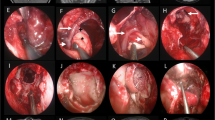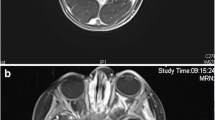Abstract
Objective
Optic pathway gliomas (OPGs) constitute approximately 3–5% of childhood intracranial tumors. In this study, the authors presented their experience of using the endoscopic endonasal approach to treat patients with OPG located in the chiasma-hypothalamic region and aimed to use the infrachiasmatic corridor in the endoscopic endonasal approach as an alternative to the transcranial approach in the surgical necessity of OPGs.
Methods
We retrospectively analyzed the data of ten patients diagnosed with OPG histopathologically among 3757 cases who underwent endoscopic endonasal surgery between August 1997 and March 2021 at Kocaeli University Faculty of Medicine Pituitary Research Center and Department of Neurosurgery. Mean follow-up period 48.5 months. During the postoperative follow-up period, 3 of these 10 patients underwent reoperation due to tumor recurrence. Combined (endoscopic endonasal approach + transcranial approach) approach was applied to 2 patients in the same session. Surgical and clinical outcomes were evaluated in detail.
Results
Ten patients with a mean patient age of 20.6 ± 11.4 were included in this study. The most common complaint was visual impairment. After surgery, improvement in visual impairment was observed in five patients. No increase in postoperative visual impairment was observed in any of the patients. Postoperative panhypopituitarism was not observed in any of the patients. STR resection was performed in 5 patients and NTR resection in 5 patients. No additional treatment was required during follow-up in 4 of 5 patients who underwent NTR. A total of 6 patients received postoperative radiotherapy treatment.
Conclusions
In gliomas located in the chiasma-hypothalamic region, appropriate patient selection and endoscopic endonasal surgical treatment may contribute to the elimination of symptoms due to the mass effect of the tumor. It may also contribute to keeping the disease under control with targeted adjuvant therapies by clarifying the pathological diagnosis of the lesion.





Similar content being viewed by others
Availability of data and material
The data and materials of the patients used in the study are in the archive of our hospital.
References
Hill CS, Khan M, Phipps K, Green K, Hargrave D, Aquilina K (2021) Neurosurgical experience of managing optic pathway gliomas. Childs Nerv Syst 37(6):1917–1929
Binning MJ, Liu JK, Kestle JR, Brockmeyer DL, Walker ML (2007) Optic pathway gliomas: a review. Neurosurg Focus 23(5):E2
Toth CA, Freedman SF, El-Dairi M, Vajzovic L (2019) Handbook of pediatric retinal OCT and the eye-brain connection E-Book. Elsevier Health Sciences
Bin Abdulqader S, Al-Ajlan Z, Albakr A, Issawi W, Al-Bar M, Recinos PF, Ajlan A (2019) Endoscopic transnasal resection of optic pathway pilocytic astrocytoma. Childs Nerv Syst 35(1):73–81
Hidalgo ET, Kvint S, Orillac C, North E, Dastagirzada Y, Chang JC, Wisoff JH (2019) Long-term clinical and visual outcomes after surgical resection of pediatric pilocytic/pilomyxoid optic pathway gliomas. J Neurosurg Pediatr 24(2):166–173
Goodden J, Pizer B, Pettorini B, Williams D, Blair J, Didi M, Mallucci C (2014) The role of surgery in optic pathway/hypothalamic gliomas in children. J Neurosurg Pediatr 13(1):1–12
Taylor T, Jaspan T, Milano G, Gregson R, Parker T, Ritzmann T, Walker D (2008) Radiological classification of optic pathway gliomas: experience of a modified functional classification system. Br J Radiol 81(970):761–766
Chikai K, Ohnishi A, Kato T, Ikeda J, Sawamura Y, Iwasaki Y, Nagashima K (2004) Clinico-pathological features of pilomyxoid astrocytoma of the optic pathway. Acta Neuropathol 108(2):109–114
Louis DN, Ohgaki H, Wiestler OD, Cavenee WK, Burger PC, Jouvet A, Kleihues P (2007) The 2007 WHO classification of tumours of the central nervous system. Acta Neuropathol 114(2):97–109
Janss AJ, Grundy R, Cnaan A, Packer RJ, Zackai EH, Sutton LN, Radcliffe J (1995) Optic pathway and hypothalamic/chiasmatic gliomas in children younger than age 5 years with a 6-year follow-up. Cancer 75(4):1051–1059
Fouladi M, Wallace D, Langston JW, Mulhern R, Rose SR, Gajjar A, Sanford RA, Merchant TE, Jenkins JJ, Kun LE, Heideman RL (2003) Survival and functional outcome of children with hypothalamic/chiasmatic tumors. Cancer Interdiscipl Int J Am Cancer Soc 97(4):1084–1092
Burkhard C, Di Patre PL, Schüler D, Schüler G, Yaşargil MG, Yonekawa Y, Ohgaki H (2003) A population-based study of the incidence and survival rates in patients with pilocytic astrocytoma. J Neurosurg 98(6):1170–1174
Fried I, Tabori U, Tihan T, Reginald A, Bouffet E (2013) Optic pathway gliomas: a review. CNS Oncology 2(2):143–159
Thomas RP, Gibbs IC, Xu LW, Recht L (2015) Treatment options for optic pathway gliomas. Curr Treat Options Neurol 17(2):1–10
Ahn Y, Cho BK, Kim SK, Chung YN, Lee CS, Kim IH, Wang KC (2006) Optic pathway glioma: outcome and prognostic factors in a surgical series. Childs Nerv Syst 22(9):1136–1142
Medlock MD, Scott M (1997) Optic chiasm astrocytomas of childhood. Pediatr Neurosurg 27(3):129–136
Astrup J (2003) Natural history and clinical management of optic pathway glioma. Br J Neurosurg 17(4):327–335
Society of British Neuro-Oncology (2011) Rare Brain and CNS Tumours Guidelines in collaboration with the National Cancer Action Team: guidelines on the diagnosis and management of Optic Pathway Glioma (OPG)
Ceylan S, Anik I, Koc K, Cabuk B (2015) Extended endoscopic transsphenoidal approach infrachiasmatic corridor. Neurosurg Rev 38(1):137–147
Ceylan S, Caklili M, Emengen A, Yilmaz E, Anik Y, Selek A, Anik I (2021) An endoscopic endonasal approach to craniopharyngioma via the infrachiasmatic corridor: a single center experience of 84 patients. Acta Neurochir 163(8):2253–2268
Fatemi N, Dusick JR, de Paiva Neto MA, Malkasian D, Kelly DF (2009) Endonasal versus supraorbital keyhole removal of craniopharyngiomas and tuberculum sellae meningiomas. Oper Neurosurg 64(suppl_5):ons269–ons287
Schwartz TH (2014) An eyebrow for an eyebrow and a nose for a nose. World Neurosurg 1(82):e97–e99
Zoli M, Mazzatenta D, Valluzzi A, Marucci G, Acciarri N, Pasquini E, Frank G (2014) Expanding indications for the extended endoscopic endonasal approach to hypothalamic gliomas: preliminary report. Neurosurg Focus 37(4):E11
Zhou ZY, Wang XS, Gong Y, La Ali Musyafar O, Yu JJ, Huo G, Yang G (2021) Treatment with endoscopic transnasal resection of hypothalamic pilocytic astrocytomas: a single-center experience. BMC Surg 21(1):1–9
Sharafeddine H, Hamideh D, Morsi RZ, Najjar MW (2021) Surgical techniques in the management of supratentorial pediatric brain tumors: 10 years’ experience at a tertiary care center in the Middle East. Surg Neurol Int 12
Jahraus CD, Tarbell NJ (2006) Optic pathway gliomas. Pediatr Blood Cancer 46(5):586–596
Shapey J, Danesh-Meyer HV, Kaye AH (2011) Diagnosis and management of optic nerve glioma. J Clin Neurosci 18(12):1585–1591
Bianchi-Marzoli S, Brancato R (1994) Tumors of the optic nerve and chiasm. Curr Opin Ophthalmol 5(6):11–17
Penman CL, Faulkner C, Lowis SP, Kurian KM (2015) Current understanding of BRAF alterations in diagnosis, prognosis, and therapeutic targeting in pediatric low-grade gliomas. Front Oncol 5:54
Wisoff JH, Abbott R, Epstein F (1990) Surgical management of exophytic chiasmatic-hypothalamic tumors of childhood. J Neurosurg 73(5):661–667
Hoffman HJ, Humphreys RP, Drake JM, Rutka JT, Becker LE, Jenkin D, Greenberg M (1993) Optic pathway/hypothaiamic gliomas: a dilemma in management. Pediatr Neurosurg 19(4):186–195
Yoshikawa G, Nagata K, Kawamoto S, Tsutsumi K (2003) Remarkable regression of optic glioma in an infant: case illustration. J Neurosurg 98(5):1134–1134
Colosimo C, Cerase A, Maira G (2000) Regression after biopsy of a pilocytic opticochiasmatic astrocytoma in a young adult without neurofibromatosis. Neuroradiology 42(5):352–356
Ater JL, Zhou T, Holmes E, Mazewski CM, Booth TN, Freyer DR, Pollack IF (2012) Randomized study of two chemotherapy regimens for treatment of low-grade glioma in young children: a report from the Children’s Oncology Group. J Clin Oncol 30(21):2641
Komotar RJ, Burger PC, Carson BS, Brem H, Olivi A, Goldthwaite PT, Tihan T (2004) Pilocytic and pilomyxoid hypothalamic/chiasmatic astrocytomas. Neurosurgery 54(1):72–80
Farazdaghi MK, Katowitz WR, Avery RA (2019) Current treatment of optic nerve gliomas. Curr Opin Ophthalmol 30(5):356
Avery RA, Fisher MJ, Liu GT (2011) Optic pathway gliomas. J Neuroophthalmol 31(3):269–278
Liu Y, Hao X, Liu W, Li C, Gong J, Ma Z, Tian Y (2018) Analysis of survival prognosis for children with symptomatic optic pathway gliomas who received surgery. World Neurosurg 109:e1–e15
Alsaleh S, Albakr A, Alromaih S, Alatar A, Alroqi AS, Ajlan A (2020) Expanded transnasal approaches to the skull base in the Middle East: where do we stand? Ann Saudi Med 40(2):94–104
Wang J, Jia J, Hou Z, Yuan X, Sun G, Niu J, Li Z (2018) Endoscopic transsphenoidal surgery for an adult patient with giant exophytic chiasmatic/hypothalamic glioma. J Craniofac Surg 29(5):e499–e502
Somma T, Solari D, Beer-Furlan A, Guida L, Otto B, Prevedello D, Cappabianca P (2017) Endoscopic endonasal management of rare sellar lesions: clinical and surgical experience of 78 cases and review of the literature. World Neurosurg 100:369–380
El Beltagy MA, Reda M, Enayet A, Zaghloul MS, Awad M, Zekri W, El-Khateeb N (2016) Treatment and outcome in 65 children with optic pathway gliomas. World Neurosurg 89:525–534
Paluzzi A, Fernandez-Miranda JC, Pinheiro-Neto C, Alcocer-Barradas V, Lopez-Alvarez B, Gardner P, Snyderman C (2011) Endoscopic endonasal infrasellar approach to the sellar and suprasellar regions. Skull Base 21(05):335–342
Arbolay OL, González JG, González RH, Gálvez YH (2009) Extended endoscopic endonasal approach to the skull base. Minim Invasive Neurosurg 52(03):114–118
Kassam A, Thomas AJ, Snyderman C, Carrau R, Gardner P, Mintz A, Pollack IF (2007) Fully endoscopic expanded endonasal approach treating skull base lesions in pediatric patients. J Neurosurg Pediatr 106(2):75–86
de Divitiis E, Cavallo LM, Cappabianca P, Esposito F (2007) Extended endoscopic endonasal transsphenoidal approach for the removal of suprasellar tumors: Part 2. Neurosurgery 60(1):46–59
Author information
Authors and Affiliations
Contributions
The idea for the article came up by Savas Ceylan. Savas Ceylan, Eren Yilmaz, and Ecem Cemre Ceylan carried out the literature review and data analysis. Eren Yilmaz, Atakan Emengen, Burak Cabuk, Ihsan Anik, and Savas Ceylan wrote the main manuscript text and Ecem Cemre Ceylan prepared Figs. 2, 3, 4, and 5. All authors read and approved the final manuscript.
Corresponding author
Ethics declarations
Ethics approval and consent to participate
The study has the approval of the ethics committee. Consent was obtained from the adult patients included in the study and the parents of patients younger than 18 years old.
Consent for publication
Consent was obtained from the patients included in the study to publish their data in a journal article. This consent was obtained from the adult patients themselves and from the parents of the patients younger than 18 years old.
Competing interests
The authors declare no competing interests.
Additional information
Publisher's Note
Springer Nature remains neutral with regard to jurisdictional claims in published maps and institutional affiliations.
Rights and permissions
Springer Nature or its licensor holds exclusive rights to this article under a publishing agreement with the author(s) or other rightsholder(s); author self-archiving of the accepted manuscript version of this article is solely governed by the terms of such publishing agreement and applicable law.
About this article
Cite this article
Yilmaz, E., Emengen, A., Ceylan, E.C. et al. Endoscopic transnasal surgery in optic pathway gliomas located in the chiasma-hypothalamic region: case series of ten patients in a single-center experience and endoscopic literature review. Childs Nerv Syst 38, 2071–2082 (2022). https://doi.org/10.1007/s00381-022-05665-7
Received:
Accepted:
Published:
Issue Date:
DOI: https://doi.org/10.1007/s00381-022-05665-7




